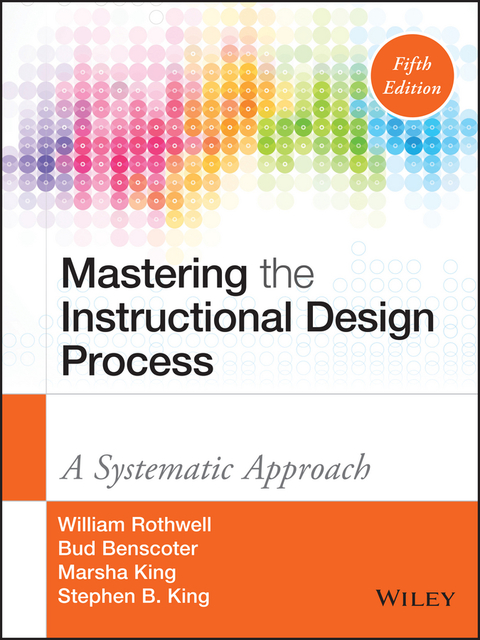Description
Efnisyfirlit
- Title Page
- Copyright
- Dedication
- Preface to the Fifth Edition
- Acknowledgments
- About the International Board of Standards for Training, Performance, and Instruction
- Advance Organizer
- The Advance Organizer
- Scoring and Interpreting the Advance Organizer
- About This Book
- Why Is This Topic Important?
- What Can You Achieve with This Book?
- How Is This Book Organized?
- How Is the Fifth Edition Different from the Fourth Edition?
- Part One: Overview
- Chapter One: An Overview of Instructional Design
- Instructional Design: An Emerging Profession
- Instructional Design: Focused on Establishing and Maintaining Efficient and Effective Human Performance
- Instructional Design: Guided by a Model of Human Performance
- Instructional Design: Carried Out Systematically
- Instructional Design: Based on Open Systems Theory
- Instructional Design: Oriented to Finding and Applying the Most Cost-Effective Solutions to Human Performance Problems
- Criticisms of Traditional Instructional Approaches
- Part Two: Planning and Analyzing for Instructional Design
- Chapter Two: Conducting a Needs Assessment
- Defining Terms
- Steps in Developing Needs Assessment
- Developing a Needs Assessment Plan: A Case Study
- Solving Problems in Conducting Needs Assessments
- Identifying Instructional Problems
- Ethical Issues in Needs Assessment
- Chapter Three: Collecting and Analyzing Data for Instructional Design Projects
- The Nature of Data
- The Data Collection Process
- Data Analysis
- Chapter Four: Identifying the Target Population and Environmental Characteristics
- Selecting Learner Characteristics for Assessments
- Selecting Learner Characteristics: A Case Study Example
- When Should Learner Characteristics Be Assessed?
- Chapter Five: Using Analytical Techniques to Determine Instructional Content
- Identify Content Aligned with Needs Assessment Findings
- Elicit, Synthesize, and Validate Content from Subject Matter Experts
- Analyze Instructional Products to Determine the Adequacy of Content, Instructions, and Learning to Determine Content Coverage
- Determine Subordinate and Prerequisite Skills and Knowledge
- Analyze Content
- Chapter Six: Analyzing the Potential Use of Existing and Emerging Technologies
- E-Learning
- The Effectiveness of Today’s Instructional Technology
- Part Three: Designing and Developing for Instructional Design
- Chapter Seven: Using an Instructional Design Process Appropriate for a Project
- Selecting or Creating an Instructional Design Process Based on the Project
- Modifying the Instructional Design Process as Project Parameters Change
- Describing a Rationale for the Selected, Created, or Modified Instructional Design Process
- Chapter Eight: Organizing Instructional Programs and/or Products
- Determine the Overall Scope of Instructional Programs
- Specify and Sequence the Anticipated Learning and Performance Outcomes
- Chapter 9: Designing Instructional Interventions
- Identifying Instructional Strategies Aligned with Instructional Goals and Anticipated Learning Outcomes
- Choosing an Appropriate Instructional Strategy
- Choosing Media and Delivery Methods
- Selecting Delivery Modes
- Appreciating the Learner’s Perspective: A Brief Overview of Cognitive Strategies
- Using Appropriate Message, Visual, and Motivational Design Principles
- Accommodating Social, Cultural, Political, and Other Individual Factors Influencing Learning
- Chapter Ten: Planning Noninstructional Interventions
- Identifying Appropriate Noninstructional Interventions
- Feedback Options
- Job Performance Aids
- Reward Systems
- Employee Selection Practices
- Organizational Redesign
- Justifying Appropriate Noninstructional Interventions
- Creating Design Specifications for Noninstructional Interventions
- Chapter Eleven: Selecting or Modifying Existing Instructional Materials
- Selecting, Developing, or Modifying Instructional Materials
- Conducting Cost-Benefit Analyses to Decide Whether to Use or Modify Existing Materials
- Validating Selection or Modification of Existing Instruction
- Chapter Twelve: Developing Instructional Materials
- Developing Media Specifications
- Producing Instructional Materials in Various Delivery Formats
- Developing Materials Aligned with Content Analysis, Proposed Technologies, Delivery Methods, and Instructional Strategies
- Collaborating with Production Specialists
- Chapter Thirteen: Designing Learning Assessments
- Introduction
- An Overview of Steps in Preparing Instruments
- Constructing Reliable and Valid Methods of Assessing Learning and Performance
- Ensuring the Assessment Is Aligned with Instructional Goals, Anticipated Learning Outcomes, and Instructional Strategies
- Part Four: Evaluating and Implementing Instructional Design
- Chapter Fourteen: Evaluating Instructional and Noninstructional Interventions
- Purpose and Definitions of Evaluation
- Formative Evaluation
- Developing a Formative Evaluation Plan
- Four Major Approaches to Conducting Formative Evaluation
- Summative Evaluations
- Reporting Evaluation Results
- Creating the Report
- Disseminating the Report
- Chapter Fifteen: Revising Instructional and Noninstructional Solutions Based on Data
- Types of Revisions
- Gaining Stakeholder Support for Revisions
- Implementing Revisions to Delivery of Products/Programs
- Chapter Sixteen: Implementing Instructional and Noninstructional Interventions
- Creating a Vision for Change
- Planning for the Implementation and Dissemination of the Intervention
- Planning for Diffusion of the Intervention
- Encouraging and Achieving Adoption and Buy-In
- Compliance versus Gaining Commitment
- Monitoring Implementation, Dissemination, and Diffusion to Identify Potential Adjustments
- Taking Action on Deviations or Problems Surfaced through Monitoring
- Part Five: Managing Instructional Design
- Chapter Seventeen: Applying Business Skills to Managing the Instructional Design Function
- Where Instructional Design Fits into the Larger Organization
- Contributing to the Organizational Purpose and Strategy
- Implementing Standards
- Leveraging Internal and External Resources to Accomplish Project Goals and Objectives
- Managing Instructional Design Talent
- Marketing and Communicating about Instructional Design
- Navigating Organizational Culture, Structure, Politics, and Processes
- Chapter Eighteen: Managing Partnerships and Collaborative Relationships
- Identifying and Engaging Stakeholders
- Building Relations between Instructional Designers and Individuals or Group Members
- Managing Cross-Functional Teams
- Securing Commitment
- Conducting Project Reviews
- Chapter Nineteen: Planning and Managing Instructional Design Projects
- Unique Challenges Posed by Project Management
- Allocating Resources to Support the Project Plan
- Part Six: Predicting the Future of Instructional Design
- Chapter Twenty: Predicting the Future of Learning and Instructional Design
- Technological Advances to Improve Delivery and Design
- The Impact of Neuroscience Research on Instructional Systems Design
- A Final Word
- About the Authors
- References
- Index
- End User License Agreement






